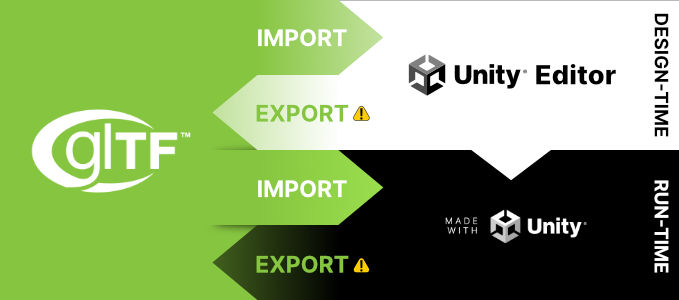Unity glTFast Documentation
Unity glTFast enables use of glTF™ (GL Transmission Format) asset files in Unity.
It focuses on speed, memory efficiency and a small build footprint while also providing:
- 100% glTF 2.0 specification compliance
- Ease of use
- Robustness and Stability
- Customization and extensibility for advanced users
Features
Unity glTFast supports the full glTF 2.0 specification and many extensions. It works with Universal, High Definition and the Built-In Render Pipelines on all platforms.
See the comprehensive list of supported features and extensions.
Workflows
There are four use-cases for glTF within Unity
- Import
- Runtime Import/Loading in games/applications
- Editor Import (i.e. import assets at design-time)
- Export
- Runtime Export (save and share dynamic, user-generated 3D content)
- Editor Export (Unity as glTF authoring tool)

Runtime Import/Loading
Load and instantiate glTF files at runtime in your game/application via Script or the GltfAsset component.
Benefits of Runtime Import
- Efficiently load dynamic and/or third-party assets
- Make use of state-of-the art mesh and texture compression methods, like KTX™/Basis Universal, Draco™ and meshoptimizer.
- No need to re-build your application or Asset Bundles upon Unity version upgrades
glTF was specifically designed for vendor-independent transmission and runtime loading and naturally plays its strengths there.
Editor Import (Design-Time)
Although primarily designed for runtime, glTF's effective design and its modern, physically-based material definition make it great for most simple DCC (digital content creation) interchange as well.
Read about usage below.
Benefits of Editor Import
- Less friction between artists and developers due to glTF as standardized interface
- Example: artists don't need to know or follow Unity shader specific conventions and thus developers don't need to instruct them
- Enables adding rich interaction and behavior to assets (e.g. custom scripts or animation controllers)
- In conjunction with Editor Export, Unity becomes a complete tool for re-mixing 3D content
- 1Use default Lit (URP/HDRP) or Standard (Built-in render pipeline) materials
1: Not yet supported (see issue)
Editor Export
Use the Unity Editor as an authoring tool and export your scenes and GameObjects as glTFs.
Note: This feature is experimental
Use-cases for Editor Export
- Unity runtime loading
- Social media sharing
- Use within the vast glTF eco system, like third-party viewers or asset pipelines
- Archiving
Runtime Export
Allows your Unity-powered application/game to export scenes/GameObjects to glTF at runtime.
Use-cases for Runtime Export
- Preserve dynamic, user-generated 3D content
- Create metaverse-ready 3D snapshots of a current state / game action
- 3D product configurations (e-commerce)
- Build high level editing and authoring tools with Unity
- Social media sharing
Note: This feature is coming soon (see issue)
Trademarks
Unity® is a registered trademark of Unity Technologies.
Khronos® is a registered trademark and glTF™ is a trademark of The Khronos Group Inc.
KTX™ and the KTX logo are trademarks of the The Khronos Group Inc.
Draco™ is a trademark of Google LLC.